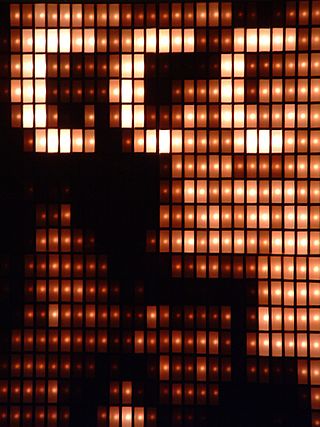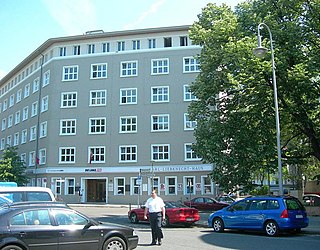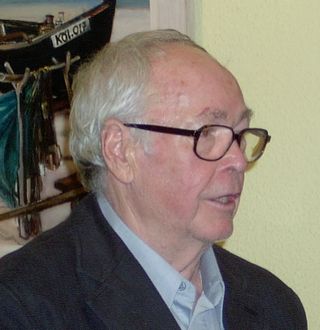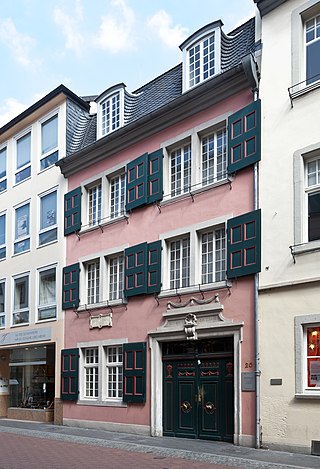
Rathaus Schöneberg is the city hall for the borough of Tempelhof-Schöneberg in Berlin, Germany. From 1949 until 1990 it served as the seat of the state senate of West Berlin and from 1949 until 1991 as the seat of the Governing Mayor.

Checkpoint Charlie was the best-known Berlin Wall crossing point between East Berlin and West Berlin during the Cold War (1947–1991), as named by the Western Allies.

Project Blinkenlights was a light installation in the Haus des Lehrers building at the Alexanderplatz in Berlin that transformed the building front into a giant low-resolution monochrome computer screen. The installation was created by the German Chaos Computer Club (CCC) and went online on 11 September 2001 as a celebration of the club's 20th birthday. Some novel uses of the screen are for people to call a number and play Pong via mobile phone or display animations sent in by the public.
Haus is a Germanic word meaning house. It may refer to:

The Haus des Rundfunks, located in the Westend district of Berlin, the capital city of Germany, is the world's oldest self-contained broadcasting centre. Designed by Hans Poelzig in 1929 after he won an architectural competition, the building contains three large centrally located broadcasting spaces, which are shielded from street noise by the surrounding office wings. It is used today by local ARD broadcaster Rundfunk Berlin-Brandenburg (RBB) to make programmes carried by its Inforadio, Kulturradio, and Radio Berlin 88,8 channels. The building's large broadcasting spaces are occasionally also used to host concerts.

Hermann Henselmann was a German architect most famous for his buildings constructed in East Germany during the 1950s and 1960s.

The Karl-Liebknecht-Haus or Karl Liebknecht House is the headquarters of the party The Left in Germany. It is located between Alexanderplatz and Rosa-Luxemburg-Platz in Berlin-Mitte.

The Prussian House of Lords in Berlin was the upper house of the Landtag of Prussia, the parliament of Prussia from 1850 to 1918. Together with the lower house, the House of Representatives, it formed the Prussian bicameral legislature. The building is now used as the seat of the German Bundesrat.

Martin-Gropius-Bau, commonly known as Gropius Bau, is an important exhibition building in Berlin, Germany. Originally a museum of applied arts, the building has been a listed historical monument since 1966. It is located at 7 Niederkirchnerstraße in Berlin-Kreuzberg,

Walter Womacka was a German Socialist Realist artist. His work was pioneering early German Democratic Republic (GDR) aesthetics.

The Detlev-Rohwedder-Haus is a building in Berlin that, at the time of its construction, was the largest office building in Europe. It was constructed between February 1935 and August 1936 to house the German Ministry of Aviation, headed by Hermann Göring, a leading Nazi.

Messe Berlin are exhibition grounds in the Charlottenburg-Wilmersdorf precinct of Berlin, Germany, at Masurenallee opposite the Haus des Rundfunks. Since 2011, they have officially been known as "Berlin ExpoCenter City" and operated by the Messe Berlin GmbH company.

The Tränenpalast is a former border crossing point between East and West Berlin, at Berlin Friedrichstraße station, which was in operation between 1962 and 1989. It is now a museum with exhibitions about Berlin during the Cold War period and about the process of German reunification. It was the border crossing for travellers on the S-bahn, U-bahn and trains going between East and West Germany. It was used only for westbound border crossings. It had separate checkpoints for West Berliners, West Germans, foreigners, diplomats, transit travellers and East Germans.

The Beethoven House in Bonn, Germany, is a memorial site, museum, and cultural institution serving various purposes. Founded in 1889 by the Beethoven-Haus association, it studies the life and work of composer Ludwig van Beethoven.

The Haus des Deutschen Sports, part of the larger Deutsches Sportforum, is a sporting venue constructed for the 1936 Summer Olympics in Berlin, Germany. Located in Olympiapark Berlin to the northeast of the Olympic Stadium, it hosted the fencing events and the fencing part of the modern pentathlon event.

Das Buddhistische Haus is a Theravada Buddhist temple complex (Vihara) in Frohnau, Berlin, Germany. It is considered to be the oldest and largest Theravada Buddhist center in Europe and has been declared a National Heritage site.

The Haus is a Grade II listed building on the Kurfürstendamm avenue between Bleibtreu and Schlüterstraße in Charlottenburg, Berlin. It was built in 1911, and has served as a hotel and as headquarters for several administrations. In 2011, the building was restored and converted to a commercial and residential building.
This page is based on this
Wikipedia article Text is available under the
CC BY-SA 4.0 license; additional terms may apply.
Images, videos and audio are available under their respective licenses.


















